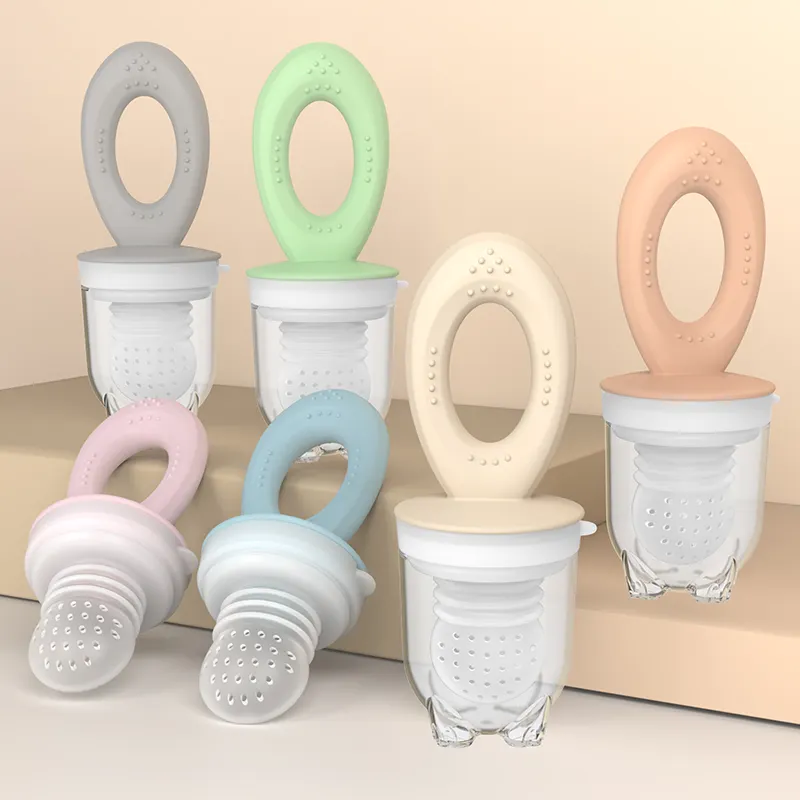Safety First: Reducing Choking Risks with Fruit Feeders
Mesh Design Minimizes Choking Hazards
The mesh design in fruit feeders plays a crucial role in ensuring the safety of infants transitioning to solid foods. This innovative design confines small pieces of fruit within a mesh pouch, allowing only pulp to pass through and significantly reducing the risk of choking. According to studies, choking incidents are a serious concern in infants around the age when they begin solid foods. Fruit feeders address this by ensuring that infants can only access small, easily digestible pieces during their exploration of new foods. Supervising feeding sessions and adhering to age recommendations are key to optimizing the safety and effectiveness of these tools. While fruit feeders provide a safer way to introduce solids, close adult supervision remains essential to ensure any unforeseen risks are mitigated.
Portion Control for Safe Exploration
Portion control is a pivotal feature of fruit feeders that can limit the amount of fruit an infant can manage at a time, thereby minimizing choking hazards. Studies suggest that careful portion control in infant feeding can prevent overconsumption and promote safe eating habits. In fact, employing portion control through fruit feeders not only ensures safety but also encourages the gradual exploration of new tastes and textures, which is beneficial for varied nutrition. Expert opinions highlight how this method helps in the progressive development of taste preferences and nourishment levels without overwhelming the infant. As children explore a wider variety of foods, fruit feeders serve as a tool to manage intake effectively, fostering a balanced diet and easing the transition onto solids.
Promoting Self-Feeding & Independence
Grip Development & Motor Skill Enhancement
Using fruit feeders can play a pivotal role in fostering grip development and enhancing motor skills in infants. As babies grasp and maneuver these feeders, they naturally practice their pincer grip, which is crucial for fine motor skill development. According to developmental psychology, self-feeding activities like these encourage the strengthening of muscles required for subsequent tasks such as holding crayons or tying shoelaces. Typically, the age range where grip development is paramount lies between 7 to 12 months, as babies transition from reflexive to voluntary grasping. By integrating these activities into daily feeding practices, we support their growth in a fun, engaging way.
Building Confidence Through Food Autonomy
Fruit feeders also offer the invaluable benefit of fostering food autonomy in children, significantly contributing to their self-confidence. Allowing children to dictate their eating choices through visually appealing feeders facilitates a unique opportunity for personal empowerment. Experts assert that self-feeding supports psychological growth by encouraging independent decision-making, enhancing confidence, and nurturing a positive relationship with food. This autonomy in feeding lays groundwork for a healthier food relationship, promoting mindful eating habits that can last a lifetime. Such self-guided experiences create a sense of pride and accomplishment, making mealtimes enjoyable and stress-free ecosystems for growth and learning.
Introducing Textures & Flavors Effortlessly
Exposure to Diverse Fruit Varieties
Fruit feeders provide an excellent opportunity to expose infants to a variety of fruits, thereby expanding their palate and encouraging the acceptance of new flavors. By introducing a wide range of fruits early on, children are more likely to develop a preference for diverse tastes and textures, reducing the likelihood of picky eating as they grow. A study published in the Journal of Pediatric Gastroenterology and Nutrition supports the notion that early exposure to a variety of foods can lead to better eating habits later in life. Additionally, this exposure contributes to a balanced diet, rich in essential vitamins and minerals. Starting such dietary practices during the complementary feeding phase—usually from 6 to 23 months, as recommended by WHO—can help establish long-term healthy eating patterns.
Sensory Stimulation Through Natural Textures
Varied textures in fruits are crucial for stimulating a baby's senses, an essential aspect of their cognitive development. These sensory experiences play a significant role in physical and mental growth, as they help infants learn about the world through touch, taste, and smell. Experts in early childhood development emphasize the importance of sensory play, and fruit feeders are an effective tool in facilitating this. They enable infants to explore and experiment with different textures safely, enhancing their sensory stimulation. Moreover, engaging with these textures through self-feeding can foster crucial skills related to exploration and discovery, aiding in their overall development.

Nutritional Benefits of Fruit Feeders
Retained Vitamins in Fresh Produce
Fruit feeders play a critical role in maintaining the nutritional quality of fresh fruits that can be lost in traditional cooking methods. The process of cooking often leads to the breakdown of vital vitamins and minerals, especially water-soluble ones like Vitamin C and B vitamins. Studies on storage methods indicate that fresh foods retain their nutrients far better than cooked ones, making fruit feeders an excellent choice for providing infants with the highest nutritional benefits. For instance, fruits such as blueberries, strawberries, and oranges are rich in essential vitamins and antioxidants, which are effectively preserved when using fruit feeders. This ensures that infants receive the necessary nutrients for healthy growth and development.
Establishing Healthy Dietary Habits Early
Introducing fruits early in a child's diet is instrumental in establishing lifelong nutritious eating habits. During the critical period of complementary feeding recommended by the WHO, infants start accepting healthy foods and beverages, forming dietary patterns that extend into adulthood. Statistics highlight alarming rates of childhood obesity, emphasizing the need for early healthy feeding practices. By using fruit feeders, caregivers can create a positive eating environment where children learn to appreciate natural flavors and textures. Pediatric dieticians advocate for the inclusion of fresh fruits in early diets to prevent obesity and encourage a balanced diet, laying a strong foundation for healthy eating habits in later years.
By integrating fruit feeders in infants' diets, we tackle nutritional deficiencies and nurture healthy eating practices, contributing to overall well-being and better growth outcomes.
Teething Relief & Oral Development
Soothing Gums with Cold Fruit Pieces
Cold fruit pieces in feeders offer significant relief for sore gums during the teething process. As dental health experts suggest, applying cold items to the gums can reduce swelling and discomfort. Fruits like chilled bananas, apples, and pears are particularly suitable due to their texture and soothing properties. To prepare these fruits for teething relief, I find slicing them into small chunks and refrigerating them before placing them in the feeder can be quite helpful. This method allows infants to explore textures safely while receiving the cooling effect crucial for teething relief.
Strengthening Jaw Muscles Safely
Fruit feeders are excellent tools for helping infants strengthen their jaw muscles through safe chewing practices. They encourage more active muscle use as they instinctively chew and suck on the fruit within the silicone pouch. Experts in pediatric oral development recommend letting babies use feeders from six months, supporting milestones in oral growth, such as increased jaw muscle strength. The controlled pieces ensure infants develop their chewing skills without the concern of choking hazards, providing a balanced approach to oral development during the early stages. By integrating fruit feeders into their routine, parents can foster safe teething practices that optimize infant oral development.
Frequently Asked Questions
Why are fruit feeders considered safer for babies?
Fruit feeders use a mesh design that confines fruit pieces, allowing only pulp to pass through, thereby minimizing choking risks. Adult supervision is still essential to ensure complete safety.
How do fruit feeders contribute to a child's independence?
Fruit feeders enable children to grasp and self-feed, fostering motor skills and independence. This autonomy supports confidence and a positive relationship with food.
Can fruit feeders help in introducing varied diets?
Yes, by using fruit feeders, infants are exposed to a range of fruits and textures early on, which encourages diverse taste preferences and reduces picky eating tendencies.
Do fruit feeders aid in teething relief?
Fruit feeders offer a safe method for teething relief by allowing cold fruit pieces to soothe infants' sore gums while providing an opportunity for oral development.

